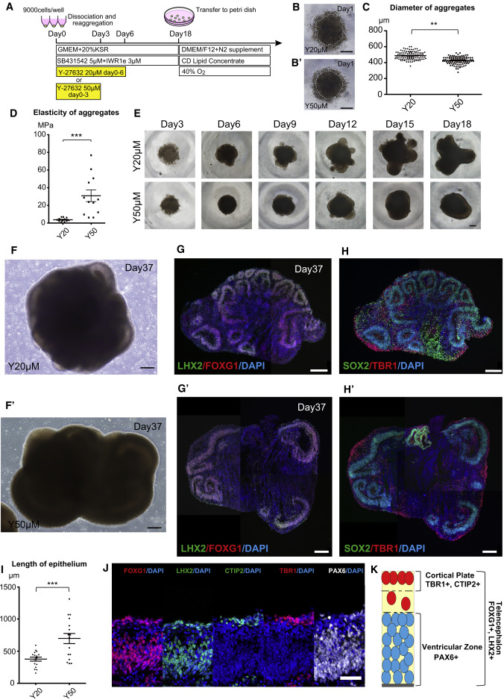Jul 02 2019
Making Mini-Brains from Stem Cells
A new report details the progress scientists have made in developing brain organoids from stem cells. They use human embryonic stem cells to culture neurons – brain cells. Lead author, Hideya Sakaguchi, describes the process:
the progress scientists have made in developing brain organoids from stem cells. They use human embryonic stem cells to culture neurons – brain cells. Lead author, Hideya Sakaguchi, describes the process:
“The team cultured the organoids for 70-100 days, dissociated them into single cells and then disseminated them into another culture dish. The disseminated cells created neuronal networks in a self-organized manner.”
Just by culturing individual neurons together, they spontaneously formed networks and some three-dimensional tissue structure, forming into layers similar to the layers seen in human cortex. Further, the networks of neurons demonstrated some coordinated firing. There was both spontaneous individual cell activity, as well as synchronized activity within networks of cells.
The result is not a brain, which is why it is called an organoid (often referred to as a mini-brain, but this is less technically accurate). What this demonstrates is the inherent properties of human brain neurons to spontaneously form tissue structure and to from neural networks that are functional. The cells are essentially trying to self-organize into a brain. They cannot fully do this, however, because there is a huge piece missing – sensory input and the feedback from output.
A human brain, even an infant brain, contains more information by orders of magnitude than is contained in all the genes that are involved in neurological function. The genes are not a blue print for a brain. Rather, the genes are a set of instructions, of behaviors, that if followed allow for the development of a fully formed brain. But that development requires more information – information from the rest of the body. This process continues after birth as babies develop their vision, hearing ability to move, eventually to walk, socialization, and language. If deprived of stimulation in these areas, the relevant part of the brain will not develop.
Developing neural networks are looking for information – their function depends both on being networked with something (another part of the brain, or a sensory input) that brings them information. They then process that information in some way and send it on to the next link in the chain. In this way there are continuous overlapping networks that incorporate both input and output, with feedback from the output functioning as further input. The brain is talking to the body, the body is talking to the brain, and the brain is talking to itself in a continuous process we experience as consciousness.
So what happens to a clump of neural tissue and networks in a vat? Nothing. It can’t do anything because it has no input or output. It’s just talking to itself about nothing. There is no chance such organoids will become conscious in any way. So what use are they?
While they are not functioning brains, they are brain tissue and therefore can potentially be used for brain research. Already we are learning something about what neurons are capable of and their inherent developmental potential. Researchers may be able to provide some sensory stimulation to see how the neural networks react. It might even be possible to control the development and function of those networks – perhaps making biological calculators. Of course, the more we go down this road the closer we get to a brain-in-a-vat, and therefore the more ethical concerns.
Meanwhile researchers can potentially use the organoids for drug research. They are biologically functioning brain cells, and so can be a useful model for pre-clinical research. Drugs, for example, may increase or decrease the activity of the networks, or change the number of connections. That seems like the low-hanging fruit to me – in-vitro testing prior to animal testing. More complex would be using organoids as a disease model. But perhaps we can learn something about specific disease states by reproducing aspects of those diseases in the organoids.
Further, while this was not mentioned in the article itself, it’s possible that knowledge we gain from examining these spontaneous neural networks may help us develop artificial neural networks in the next generation of computers, including those that may one day form the basis of artificial general intelligence. The more we know about how such networks spontaneously form, and how they adapt to input and output in order to produce a specific function, the more we will be able to reproduce it with artificial neurons.
And again, at this stage there are no ethical concerns, because we are nowhere near consciousness or any self-awareness. But it is easy to see how quickly we can get there. There is a layer of weirdness to the very idea of brain tissue in a vat, because I think we are naturally uncomfortable with the very notion that our consciousness is the result of a clump of tissue shuttling ions around. It breaks the illusion that our brains evolved to have, a very compelling and persistent illusion – namely that the reality we perceive is real, rather than a constructed representation. That internal representation has a strong relationship to physical reality, but the two are not the same, and the relationship can break down in many ways (which give us weird glimpses behind the neurological veil).
Anything that reduces all this to cellular activity, which we can see in a petri dish, just slaps us in the face with this reality. Of course, I think it’s best to just accept it and to fully understand our true nature than to persist in metaphysical delusions.






